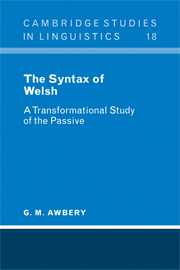Summary
In this chapter an analysis of the structure of active sentences is presented, which will provide a basis for the discussion of passive forms in later chapters. In section I.I simple active sentences are considered, and in sections 1.2 to 1.5 sentences containing periphrastic forms of the verb are discussed. It is suggested that they should be analysed as complex sentences containing a tenseless embedding.
Simple active sentences
Phrase structure The simple active sentence in Welsh consists of a sentence-initial verb, which is followed by the subject, object and any prepositional phrases in this order. Examples are given below.
(1) Diflannodd y ci.
Disappeared the dog.
(2) Gwelodd y dyn y ci.
Saw the man the dog.
(3) Soniodd y dyn am y ci.
Spoke the man about the dog.
(4) khoddodd y dyn y ffon i'r ci.
Gave the man the stick to the dog.
In traditional grammars of Welsh it is assumed that the sentence consists of two units, subject and predicate (Richards 1938 p. 5). This view is retained in more recent, structurally orientated, treatments such as Watkins (1961). The motivation for this division into subject and predicate seems to be a universalist semantic one rather than syntactic. For instance Watkins claims that ‘it is difficult to imagine any kind of language which would not include something to talk about (subject) and something to say about it (predicate)’ (Watkins 1961 p. 183).
- Type
- Chapter
- Information
- The Syntax of WelshA Transformational Study of the Passive, pp. 5 - 46Publisher: Cambridge University PressPrint publication year: 1977



